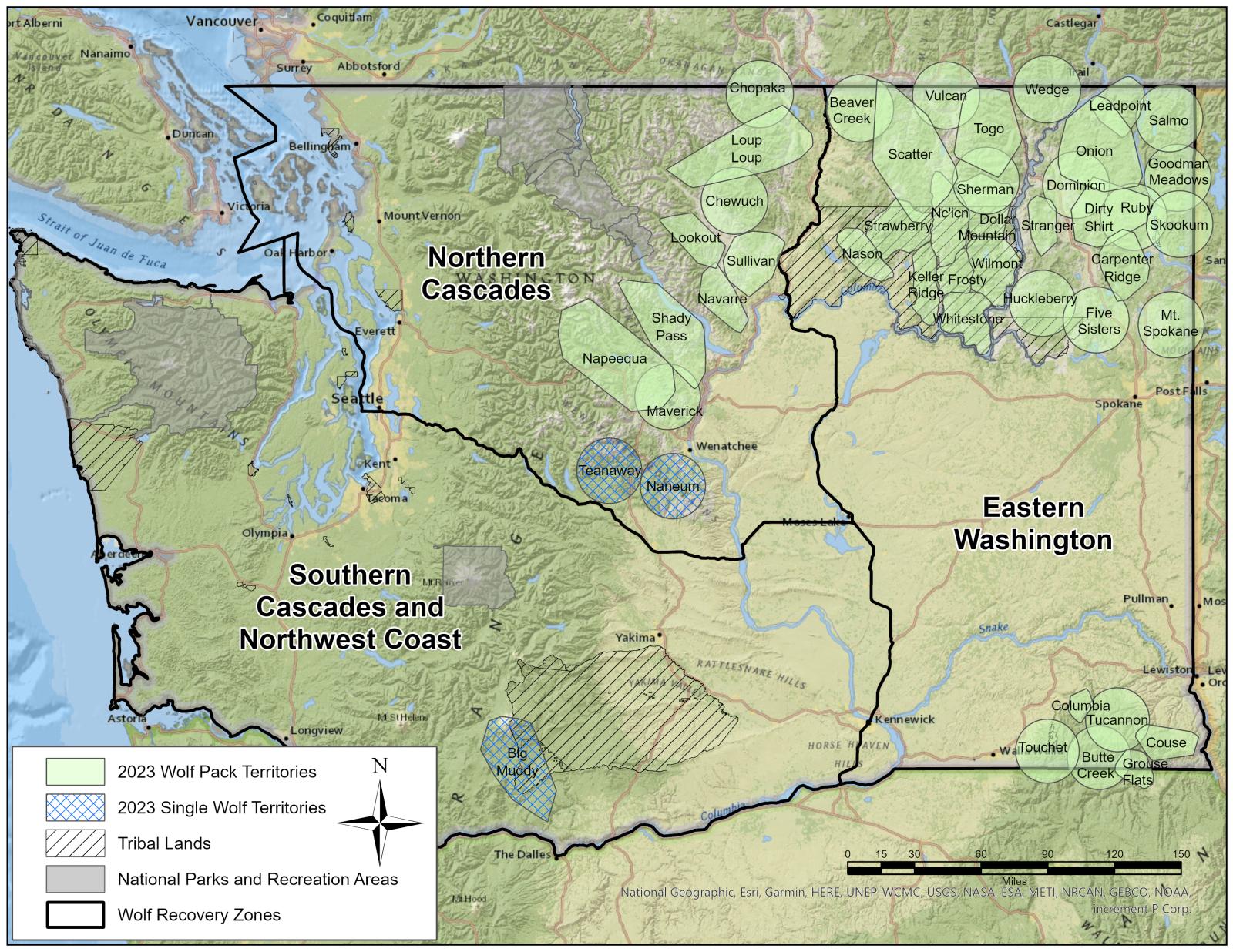News release
Staci Lehman, (509) 710-4511
OLYMPIA – Washington’s wolf population grew for the 15th consecutive year in 2023, according to the Washington Gray Wolf Conservation and Management 2023 Annual Report, released today by the Washington Department of Fish and Wildlife (WDFW).
The report shows a 20% increase in wolf population growth from the previous count in 2022. As of Dec. 31, 2023, WDFW and partnering tribes counted 260 wolves in 42 packs in Washington. Twenty-five of the packs were successful breeding pairs that raised at least two pups through the end of the calendar year. These numbers follow the previous year’s count of 216 wolves in 37 packs and 26 breeding pairs.
“Although the first pack to recolonize the South Cascades and Northwest Coast recovery region only had one wolf during the year end counts in 2023, we have observed multiple collared wolves south of Interstate 90 in the last year,” said WDFW Director Kelly Susewind. “This likely means it is only a matter of time before new packs begin to establish in that recovery region.”
Seven packs formed or reestablished in 2023 including the Beaver Creek pack in Okanogan County, the Skookum pack in Pend Orielle County, Ruby pack in Stevens County, the Couse pack in Asotin County, and the Dollar Mountain, Nason, and Scatter packs in Ferry County that overlap portions of the Confederated Tribes of the Coville Reservation (CTCR). As occurs each year, the numbers of animals within a pack, or the status of a pack, fluctuates.
Wolves are counted annually through activities like track, aerial, and camera surveys. As in past years, survey results represent minimum counts of wolves in the state due to the difficulty of counting for every animal – especially lone wolves that do not belong to a pack.
Because this is a minimum count, the actual number of wolves in Washington is higher. Since the first WDFW survey in 2008, the state’s wolf population has grown by an average of 23% per year.
While wolf numbers in Washington grew, reported depredations on domestic animals didn’t increase correspondingly. WDFW documented 23 confirmed or probable depredation events in 2023. Seventy-eight percent of wolf packs were not involved in any livestock depredations, while 21% of known wolf packs (9 packs) were involved in at least one confirmed or probable depredation. Only two packs were involved in two or more depredations, even though many of the pack territories overlap livestock operations.
“Livestock producers have worked closely with WDFW staff in the past year, along with community partners and range riders, to use non-lethal methods to discourage wolves from negatively interacting with domestic animals,” said WDFW Statewide Wolf Specialist Ben Maletzke. “These proactive and reactive efforts require significant investments in time and resources by livestock operators and others but have reduced the number of wolf depredations and lethal removal of wolves.”
WDFW recently released the first-ever status review for wolves in Washington and recommended wolves be reclassified to Sensitive status based on significant progress toward recovery objectives. The Washington Fish and Wildlife Commission is expected to make a decision on the reclassification proposal in July.
Wolves remain federally listed in the western two-thirds of the state and U.S. Fish and Wildlife Service (USFWS) has the lead role in the recovery of wolves in the North Cascades and the Southern Cascades and Northwest Coast recovery regions.
Contributors to WDFW's annual wolf report include the US Fish and Wildlife Service, the National Park Service, the Spokane Tribe of Indians, Swinomish Tribe, Yakama Nation, and the Confederated Tribes of the Colville Reservation.
In addition to the Washington Gray Wolf Conservation and Management 2023 Annual Report being available on the Department’s website, a recording of today’s presentation of the report to the Fish and Wildlife Commission will be available on the website soon.
The Washington Department of Fish and Wildlife works to preserve, protect, and perpetuate fish, wildlife and ecosystems while providing sustainable fish, wildlife, and recreational and commercial opportunities.
